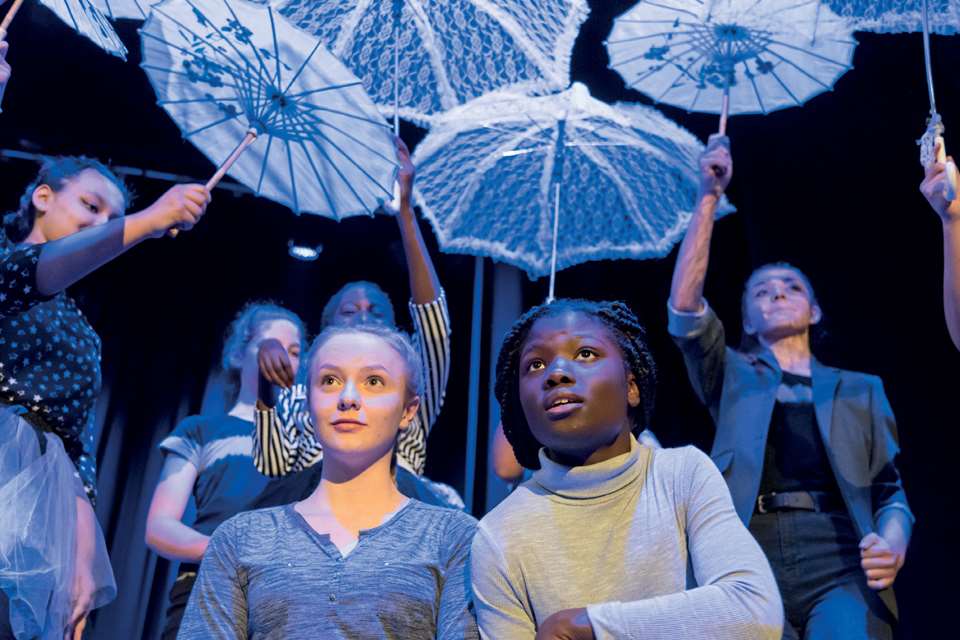Ockham's Razor: Taking Tess on tour
Laura Clark
Sunday, October 1, 2023
Thrilled by the use of physical theatre to retell such a classic tale, Laura Clark meets the Ockham's Razor team behind the touring production of Tess of the D'Urbervilles to find out more about its new offering of workshops.

Circus is traditionally perceived as a combination of acts coming together to create a full performance. But in this case, there is only one woman running the show: Tess. Ockham's Razor's re-telling delves into how this character should have been free to lead if fate and societal constraints hadn't intervened. Tess possesses a sinewy resilience that is often not portrayed in adaptations of Hardy's novel; the circus elements in this touring production, however, allows for her experiences to be physicalised in a way does justice to her strong character.
Where it all began
‘We have long experience of working with reframing the female body with circus looking at strength, capability and agency and also at danger, fear, risk and vulnerability,’ says artistic director, Charlotte Mooney, ‘it is through the physical that we are wrestling with the feminist themes inherent in the novel. Tess of the D'Urbervilles has always struck us as such a very physical and visual book. Hardy paints this story with images alongside the deep poetry of the language and at the centre of it is Tess, a character who experiences the world physically in all her journeying, labouring, desiring, and battling against the fate dealt out to her.’
This physical book sparked a visceral reaction in the Ockham's team. Mooney and co-director Alex Harvey both love the book. So, the starting point of discussing it and sketching out ideas around a kitchen table for three days was no Hardy-esque hardship. ‘What we could envisage staging physically we did.’ Mooney recalls. ‘In the parts where we needed words either to tell the story or evoke the world or atmosphere, we took paragraphs from the novel. From this we created a script that was a patchwork of parts spoken and parts we imagined being told physically.’

The set
A meeting with designer Tina Bicât to see what stitches needed to be made to bring the Wessex tapestry to life and a ‘kit of props’ was decided upon. An experimental phase then followed, which involved a week of research with a group of 10 performers, before the team returned to the kitchen table to cement the script. But how do you make ‘a vast herd of cows’ with a washing line and a linen sheet? How do you make ‘the landscapes and inner spaces of Marlott and The Slopes’? How do you make the audience feel Angel's rejection of Tess? Through ‘acrobatic repulsion’.
‘Despite being written in 1891 Tess of the D'Urbervilles still speaks to this moment in time. What it has to say about privilege, class, poverty, agency, female desire, solidarity and the need for non-industrialised agriculture are still completely relevant. It is a deeply political novel yet also pulses with such a deep vein of beauty around love and loss, heartbreak and yearning that it never feels like a polemic,’ says Bicât.
Reaching the students
GCSE and A Level students will have the chance to explore these themes and challenges, and Ockham's Razor's ‘unique devising techniques’ in a series of workshops, created in collaboration with secondary school teachers. Working with actual props and set pieces from the show, they will feature practical exercises in ‘object manipulation to create environments and stories’: how to produce ‘strong visual images which communicate subtle and complex ideas.’
A resource pack will also be available, which provides an insight into the full creative process and thoughts from the technical and artistic team, as well as digital links to footage of the show. ‘The ensemble are six incredibly skilled circus performers who use their strength and circus language to evoke the emotion and the physical labour of the novel. They create Hardy's Wessex onstage wielding a series of wooden planks, shifting walls, ropes and swathes of linen to make sets that can change and unfold and which they balance upon, climb, carry and construct to become the vast landscapes and interior worlds of Hardy's Wessex.’
‘An interested eye’
At times we see pure Tess literally walking the plank with deliberate careful steps, journeying unknowingly towards her death. In this production Tess is given the chance, albeit from the gallows, to tell the story her way, as it is in her own memory. Occasionally being pulled in the direction of real-time as she is ‘swept up by the ensemble and drawn into the action,’ Rooney explains. ‘We have also chosen to have the actor playing Tess to speak directly to the audience. So that while all the text comes directly from the novel – from Hardy – the male gaze has been replaced by the female voice.’ In fact, it's Tess who looks out at us, from parapet or precipice, in her life of constant battles and defeats, eyes bright with ‘many-coloured idealities’.
‘Let truth be told - women do as a rule live through such humiliations and regain their spirits, and look about them with an interested eye.’
- Thomas Hardy, Tess of the D'Urbervilles
Tour dates
13-15 October 2023: Unit 15, Circus City, Bristol
21-22 October 2023: Lawrence Batley, Huddersfield
14-15 November 2023: Malvern Theatre
29 November 2023: Cornerstone, Didcot
31 January-3 February 2024: London
9-10 February 2024: Traverse Theatre, Edinburgh
14-17 February 2024: The Lowry, Salford Quays
21-22 February 2024: Lighthouse Poole
March 2024 (dates TBC): Exeter, Northcott
20-21 March 2024: Artsdepot, London







